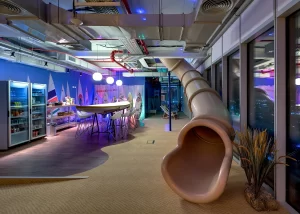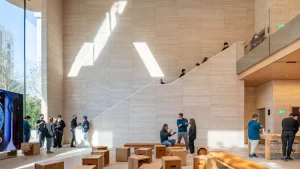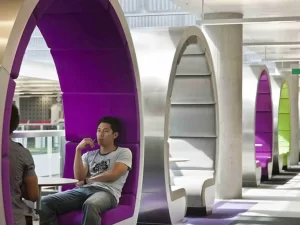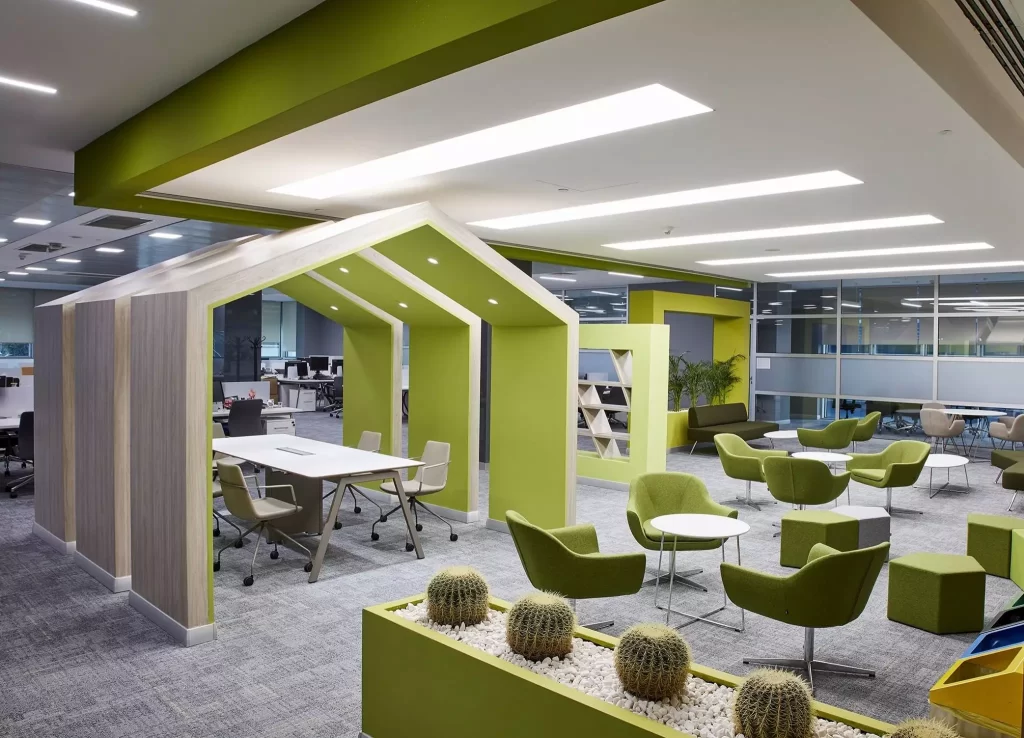Vaishali Sharma
Work is an essential part of our daily lives, and it is commonly recognised that our working environment can significantly impact our productivity, creativity, and overall well-being. In recent years, architects and interior designers have been re-conceptualising workspaces to create more engaging, inspiring, and productive environments for employees. Incorporating innovative lighting, modular furniture, greenery and more, the new office designs aim to provide a seamless blend of aesthetics and functionality.
One of the most notable examples of innovative office design is the Google Headquarters in California. The design team, led by architects from the firm BIG, focused on creating a space that encourages collaboration and fosters creativity. The design elements are practical and visually stunning, including open-plan workstations, an array of colourful breakout spaces, and a wave-like roof that mirrors the surrounding hillsides. The Google HQ also features various wellness areas, from outdoor sports courts to in-house massage and spa facilities, solidifying the concept of creating an environment that prioritises employee well-being.

Courtesy: Dezeen
These new designs are a significant departure from the sterile, cubicle-filled offices of the past and have helped to change the traditional corporate workspace towards a more open-plan and holistic working environment. Incorporating greenery and natural light has also become increasingly popular, as research has shown that exposure to nature can help reduce stress, increase productivity and creativity, and overall employee satisfaction. In addition, green walls and indoor plants provide an aesthetic centrepiece and invite a sense of calm into the office, positively affecting employee performance.
Another ground-breaking example is the Apple Spaceship campus in Cupertino, California. The office design team, led by architects Foster + Partners, designed an immersive campus with circular building footprints, with a central park in the middle. The spacious building comprises an open-plan workspace where employees work in transparent pods designed to promote collaboration and transparency. In addition, the campus features an advanced natural ventilation system that adjusts to the local climate, allowing indoor air to be circulated and filtered naturally instead of air conditioning systems. Using sustainable design elements and minimal environmental impact on this campus inspires many future mega-projects.

Courtesy: Dezeen
These innovative designs have proven to increase employee productivity, satisfaction and reduce absenteeism. In addition, the open-plan workspace design aims to increase department collaboration and communication, allowing for more innovative and efficient work pipelines. However, this new office design approach comes with potential downsides, and a significant drawback has been the acoustics of these wide-open spaces. The noise generated from the open-plan design can distract many employees, reducing productivity and stress. To overcome this, designers are incorporating acoustic materials to combat echoing and unwanted sounds that can become a nuisance.
Flexibility and modularity are also significant innovations in office design. The COVID-19 pandemic has highlighted the need for flexible office design concepts to accommodate new workplace protocols related to social distancing and remote work. As a result, companies are rethinking how their office space is used and adopting flexible or modular furniture to support it. Modular offices using prefabricated structures, for example, often feature interchangeable panels or walls, allowing for easy modification to match occupancy levels or a company’s needs.

Courtesy: Pinterest
With the pandemic affecting workspace design, many companies are now adopting flexibility as an essential criterion. The concept of a “living office”, whereby the workspace integrates with natural living environments, is gaining popularity. By emphasising sustainable and holistic environments, companies strive to promote green and eco-friendly practices while offering open, collaborative and productive environments for their employees. Innovative office designs are revolutionising workspaces by combining aesthetic appeal with practicality. These designs incorporate greenery, natural light, modular furniture, and advanced ventilation systems, paving a path from traditional office designs. Employees enjoy greater comfort, improved working environments, and higher job satisfaction with these features. As companies recognise the significance of creating a positive work environment to attract and retain employees, innovative office designs will continue to emerge as a powerful tool for boosting creativity, productivity, and employee satisfaction in the future.





